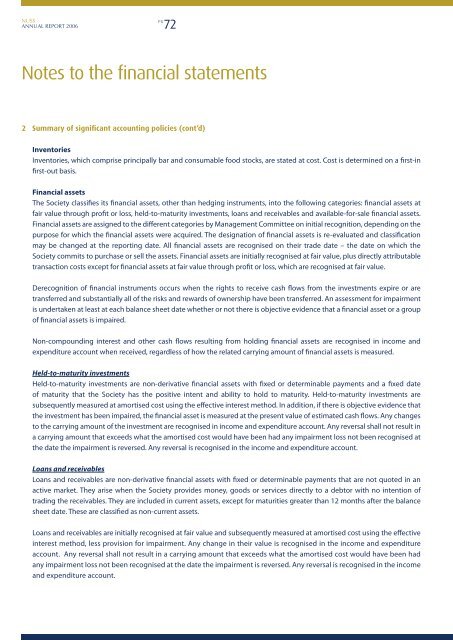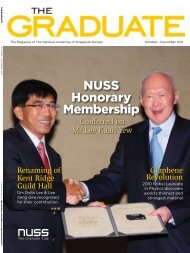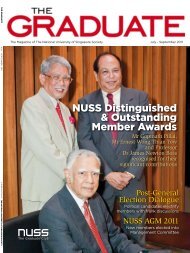Building Lifelong Relationships - NUSS
Building Lifelong Relationships - NUSS
Building Lifelong Relationships - NUSS
You also want an ePaper? Increase the reach of your titles
YUMPU automatically turns print PDFs into web optimized ePapers that Google loves.
<strong>NUSS</strong><br />
ANNUAl RepoRt 2006<br />
PG<br />
72<br />
Notes to the financial statements<br />
2 Summary of significant accounting policies (cont’d)<br />
Inventories<br />
Inventories, which comprise principally bar and consumable food stocks, are stated at cost. Cost is determined on a first-in<br />
first-out basis.<br />
Financial assets<br />
The Society classifies its financial assets, other than hedging instruments, into the following categories: financial assets at<br />
fair value through profit or loss, held-to-maturity investments, loans and receivables and available-for-sale financial assets.<br />
Financial assets are assigned to the different categories by Management Committee on initial recognition, depending on the<br />
purpose for which the financial assets were acquired. The designation of financial assets is re-evaluated and classification<br />
may be changed at the reporting date. All financial assets are recognised on their trade date – the date on which the<br />
Society commits to purchase or sell the assets. Financial assets are initially recognised at fair value, plus directly attributable<br />
transaction costs except for financial assets at fair value through profit or loss, which are recognised at fair value.<br />
Derecognition of financial instruments occurs when the rights to receive cash flows from the investments expire or are<br />
transferred and substantially all of the risks and rewards of ownership have been transferred. An assessment for impairment<br />
is undertaken at least at each balance sheet date whether or not there is objective evidence that a financial asset or a group<br />
of financial assets is impaired.<br />
Non-compounding interest and other cash flows resulting from holding financial assets are recognised in income and<br />
expenditure account when received, regardless of how the related carrying amount of financial assets is measured.<br />
Held-to-maturity investments<br />
Held-to-maturity investments are non-derivative financial assets with fixed or determinable payments and a fixed date<br />
of maturity that the Society has the positive intent and ability to hold to maturity. Held-to-maturity investments are<br />
subsequently measured at amortised cost using the effective interest method. In addition, if there is objective evidence that<br />
the investment has been impaired, the financial asset is measured at the present value of estimated cash flows. Any changes<br />
to the carrying amount of the investment are recognised in income and expenditure account. Any reversal shall not result in<br />
a carrying amount that exceeds what the amortised cost would have been had any impairment loss not been recognised at<br />
the date the impairment is reversed. Any reversal is recognised in the income and expenditure account.<br />
Loans and receivables<br />
Loans and receivables are non-derivative financial assets with fixed or determinable payments that are not quoted in an<br />
active market. They arise when the Society provides money, goods or services directly to a debtor with no intention of<br />
trading the receivables. They are included in current assets, except for maturities greater than 12 months after the balance<br />
sheet date. These are classified as non-current assets.<br />
Loans and receivables are initially recognised at fair value and subsequently measured at amortised cost using the effective<br />
interest method, less provision for impairment. Any change in their value is recognised in the income and expenditure<br />
account. Any reversal shall not result in a carrying amount that exceeds what the amortised cost would have been had<br />
any impairment loss not been recognised at the date the impairment is reversed. Any reversal is recognised in the income<br />
and expenditure account.









